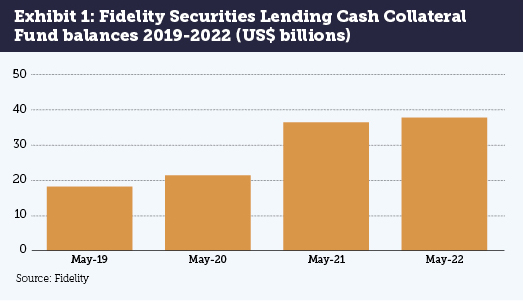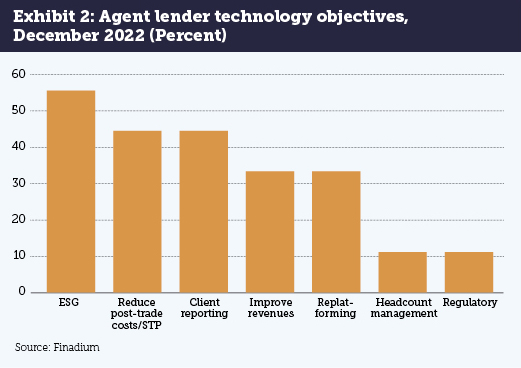Straight-through Processing (STP) and post-trade operations have become a key differentiator for borrowers and lenders in the securities lending industry. The ability to transact and transmit settlement instructions in real-time helps minimize fails and lowers costs for all parties. Borrowers may be willing to transact on more favorable terms with lenders in exchange for the opportunity to execute a more efficient transaction. In this article, we evaluate what the technology investments made by Fidelity Agency Lending (FAL) have meant for increased utilization and, as a result, greater client revenues and program satisfaction.
Fidelity Agency Lending’s strategy of technology investments
Fidelity Agency Lending has focused on reducing frictions with borrowers as a principal means of generating internal and client efficiencies. FAL launched in 2019 leveraging industry expertise from Fidelity’s National Financial Services, but with a clean technology slate as an agent lender. The group made an early decision to focus on STP and post-trade processing as a priority area.
FAL has developed ideas of configuration and customization in setting up its technology, deciding that both are important for different reasons. Yuri Brightly, head of product development at FAL, says that “Configuration is allowing clients to set parameters based on existing functionality. Customization is working with a client to establish new technological functionality that does not exist. FAL invested in its platform to support customization, allowing clients to leverage technology to achieve a tailored lending program.”
FAL created a real-time (non batch based) settlement infrastructure, which helps borrowers meet regulatory deadlines like Rule 204 and avert buy-ins. According to Justin Aldridge, head of FAL, “Since we do not use batch cycles in our trading or operational infrastructure, trade flow automation and real time connectivity with the industry means that FAL’s loans settle with borrowers/custodians in seconds.” FAL connects to all custodians directly and exchanges position information in real-time, enabling a better view of tradable inventory, including of settlements, than what is available on an overnight, or batch, basis. Real-time settlements also enable better cash forecasting, which allows beneficial owners to make more accurate investments and reduce the likelihood of under- or over-invested collateral. In a higher rate environment, this has become an important benefit.
Post-trade extends to clients having the ability to oversee and modify program parameters and risk exposure, which supports client self-sufficiency, the potential for improved returns, and program satisfaction. FAL has adopted PB OptimizeSM, Fidelity’s prime brokerage workstation, to support agency lending clients with information delivery. PB Optimize allows clients to send live messages to the agent lender for recalls and other program changes. Systemically integrating customized client rules-based lending parameters makes automated trading more accurate and efficient.
More recently in 2022, FAL created a corporate actions workstation to allow the team to see all elections and instructions across all custodians. This system provides intraday updates on loans/returns and corporate action events, and changes in this activity are highlighted to the corporate action team. The system can effectively manage the risks associated with new loan/returns as record dates get closer. The corporate actions workstation flows through to the recall system to coordinate all borrower messaging.
A focus on automated trading has helped make FAL a competitive agent lender; this extends to providing borrowers with early and almost complete access to inventory across the rate spectrum for automated trade execution. Todd Bosworth, Head of US Equity Trading at Fidelity Agency Lending, says that “FAL’s automated and real-time trading and settlements help make Fidelity an attractive agent lender to work with, and thus an early stop for borrowers to meet their needs.” Electronically agreed trades allow for increased volume and accurate booking details.
FAL’s Aldridge reports that the organizational lift in building out electronic trading efficiencies has been made easier by the Fidelity organization’s 20 years of experience in the securities lending market. He notes that “without this expertise, investment and scale in assets, launching a new agency lending business may have been unprofitable. New technology combined with an understanding of near-term industry and regulatory initiatives has allowed FAL to build a nimble and robust business to support our client’s needs. We benefitted from this combination of industry experience and the opportunity to create our own operational and technological efficiencies.”
From post-trade to client revenues
One way that borrower-friendly STP and post-trade processes are expressed is in the growth of loan activity for the clients of agent lenders. The Fidelity Funds started lending through Fidelity Agency Lending in 2019 and were the only client until the second half of 2022. The Funds invest their cash in the Fidelity Securities Lending Cash Central Fund, which makes analysis of the program’s collateral holdings for that period a straight-forward exercise.
According to public filings, Fidelity’s securities lending cash fund grew from $18 billion in May 2019 to $37.6 billion in May 2022 (see Exhibit 1). In total, the $37.6 billion held in collateral by Fidelity Funds in its securities lending program was 108% higher than the 2019 balance.

Industry data support the idea that Fidelity is outperforming on utilization. According to EquiLend’s Trading Analytics Year 2022 for US Equities, “FAL’s program consistently ranks in the top quartile for the market value of automated US equity trades against all industry participants.” Utilization is a primary driver of revenue generation in the US equities market where Fidelity is an active participant.
Industry perspectives on technology objectives
STP and post-trade efficiency are well-recognized goals in the securities lending industry. Robust internal initiatives and an active vendor community combine to make the workflow as easy as possible for borrowers and lenders across matching, trade comparisons, margin calculations and other functionalities. Not all firms have the same focus however: a December 2022 survey of agent lenders conducted by Finadium found that 44% cited STP and post-trade as one of their immediate technology objectives, partly to mitigate high internal costs and partly to support revenue generation (see Exhibit 2). Every firm must make their own determination on pain points and where investments can make the greatest impact.

The value of trading and post-trade efficiency
The financial benefits of efficient STP and post-trade activities are an active topic of securities lending industry conversation, and the cost of trade break fails is reported as one of the most frustrating elements of the business. In one scenario, a trade break for a difference of $100 could take a day or two to resolve, leading to headcount costs that are a sharp multiple of the original discrepancy. Consistent time-consuming trade breaks can cause borrowers to choose to do less business with individual agent lenders. The ability to reduce or eliminate fails can translate into significant savings in time and resources.
Finadium industry experience supports the idea that borrowers are willing to pay fair market rates to transact with efficient counterparties. While efficient lenders may not overprice, they are not often asked to bargain on rates compared to non-automated counterparties that may be asked to pay more to lend or borrow. This bifurcation in market pricing shows the importance of cost reduction that post-trade investments can bring; the eliminated costs of resolving thousands of small trade breaks adds up to significant financial benefits for both parties. That can mean higher utilization at rates that are fairly priced to market. This can also result in longer duration loans, as borrowers tend to return securities to these agents last.
The experience of Fidelity Agency Lending’s in post-trade shows the value of its investments for client satisfaction and utilization. While contract compare services, pre-trade fail analytics and projects like EquiLend’s 1Source all deliver industry-wide solutions, individual lenders and borrowers must also prioritize what they see as the most impactful steps they can take for their clients and counterparties. FAL chose settlements, STP, corporate actions and recalls, and connectivity with customers, borrowers and custodians as their first opportunities. This has resulted in improved securities lending outcomes for their beneficial owner clients.
This article was commissioned by Fidelity Agency Lending, a division of Fidelity Capital Markets. For more information about Fidelity Agency Lending, please visit i.fidelity/agencylending.com.
Fidelity Capital Markets is a division of National Financial Services LLC, a member of NYSE, SIPC.
PB Optimize is provided by Fidelity Global Brokerage Group, Inc. (FGBG), a wholly owned subsidiary of FMR LLC. FGBG is not part of Fidelity’s broker-dealer entity, National Financial Services LLC, which provides Fidelity’s other prime brokerage service offerings. The content provided herein is general in nature and is for informational purposes only. This information is not individualized and is not intended to serve as the primary or sold basis for your decisions as there may be other factors you should consider. Fidelity does not provide advice of any kind. Firms should conduct their own due diligence and determine what is appropriate for their unique situation. PB Optimize is a service mark of FMR LLC.
Finadium is an independent entity and is not affiliated with Fidelity Investments.


